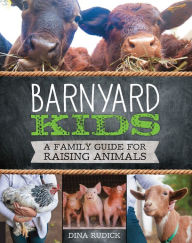
9781631590719
I feel really bad about this one. Not about the book itself, or even about my review of it. What I feel badly about is that it sat on my review pile for so long! I wanted to make sure I had enough time to really sit down and look at this one, and...well, when do we ever have enough time for anything, moms?
Most of the time, books are sent to e seemingly at random, but I specifically asked to see this title. Many of our friends here have farms of varying sizes, and there are several large ranches in the area. Two of my kids are in 4H, and members of our club have everything from pigs and cows to an extremely tame rat who steals my hoop earrings at meetings. Kids have been working family farms and dabbling in pet rabbits for centuries - so, you would think there would be a good variety of books about farm animals at their level.
Nope. Fiction, sure. Junior readers that tell you a baby sheep is called a lamb, and you should give it food and water, sure. Nonfiction geared towards upper elementary readers, with actual instructions and useful information? Not so much.
The Introduction and Foreword of Barnyard Kids caught my attention right away. In the Introduction, Rudick gives a basic overview of considerations you will need to make before deciding what type of animal, and how many, you might want to raise. Each of the chapters goes into more detail about what particular animals require, but it's nice to start the book with those questions in mind, hopefully prompting readers to keep an open mind rather than just skip to reading about the animal that strikes their fancy the most. I could immediately see this being of use to a family starting off in 4H or a Vo-Ag program, and unsure of how to get their feet wet.
In the Foreword, Ben Holmes, founder of The Farm School, outlines the history and goals of that program - which I had never heard of before! I will let readers click on the link to get more information about The Farm School, but what is pertinent here is that Rudick spent a year on what is called Maggie's Farm, and this book is written out of what she learned there. It is also worth noting that the Forword itself may add kindling to a new family's fire to get their kids involved with farming in some big or small way.
I paid most attention to the chapters on chickens, goats and rabbits, since those are animals I have raised myself (the book also includes pigs, sheep, cows and horses). I found the text to be just the level I've been looking for - about a 5th grade reading level, with actual meaty information you can use. In fact, I almost immediately found out something I didn't know - chickens can't swallow! Rudick explains why, clearly enough that a young reader could, say, explain it to a judge when she is showing her chickens at the county fair.
Each chapter has four scetions: In "What Makes Them Tick", Rudick discusses food and water needs, hygiene, instinct, and social needs of the animals (bullying chickens, a pig's love of routine, etc.).
In "What Makes Them sick", we have, quite obviously, signs and causes of illness, vaccination needs, basic medical supplies, etc. "Where Do They Live?" addresses housing - giving both general needs and some specific suggestions.
"What Can They Give" covers everything from meat or by-products you might think of (eggs, wool) to some you might not - the usefulness of pig poop, for example.
Chapters also include a Q & A for topics that weren't covered in each section, such as different breeds of each animal, and whether it can be housed with other animals (goats and chickens together are a great idea, especially if you aren't keen on scooping up goat poop). Finally, a two-page spread details the daily/weekly/monthly chores associated with each animal, which may keep some of us from getting in over our heads.
The photographs are wonderful, but occasionally misplaced - for example, opposite the Introduction, which talks about the benefits raising animals can bring, we have someone toting a crate of potatoes. What kind of chicken lays those, exactly? The diagrams and fast facts give good additional information, in keeping with the flow and age level of the text.
Overall, i was very pleased to be able to add this title to our collection, and hope to find more like it. This appears to be Rudick's only book so far - perhaps she will consider stand-alone books for each animal, maybe adding more details on different breeds, medical care, and showmanship? Just a thought!
If you have any sort of farming community in your area (or if those baby chicks at Tractor Supply are calling to you), I highly recommend purchasing a copy (published by Quarry Books).
Thank you, Ami - for this wonderful review! I really appreciate that you took the time and I'm beyond thrilled that you liked it! I laughed out loud about the rats stealing your earrings. When I was a kid, I raised rats (one at a time) and named them all Charlotte. (Charlotte I, Charlotte II, Charlotte III, etc). LOL!
ReplyDelete